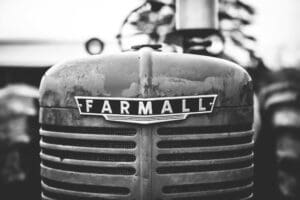My great-grandmother lived from 1901 to 2005. A day in her life was no doubt hard but also full of beauty and dignity. What she witnessed in her lifetime is stunning.

The Southerner’s primary approach to his world was not through the idea of class. He never really got around in his subconsciousness to thinking of himself as being, before all else, a member of a caste, with interests and purposes in conflict with the interests and purposes of other castes. […] Rather, he saw with essentially naïve, direct, and personal eyes. Rather, his world, as he beheld it, remained always, in its basic aspect, a simple aggregation of human units, of self-continued and self-sufficient entities, whose grouping along class lines, though it might and would count tremendously in many ways, was yet not a first thing.
— W. J. Cash, from The Mind of the South (1941)
Addie Waterson Borders lived to be 104. That means I had more than 30 years to know the woman I call Mama Borders. I got to stand at her hip when she made brown sugar toast. She told me the secret to making livermush when I was older, and I got to introduce her to my new wife when I was grown.
However you look at it, I’m lucky.
When I was in high school, Mama Borders was already old. I’d been assigned a class project to interview someone who had lived during the Great Depression. A no-brainer: I chose my great-grandmother, who—during the worst of it—would have been about my age today. Because she never suffered from dementia, the only trouble I ever had getting information out of her was when her ears were clogged, and I had to repeat a question. She would sometimes squint in her determined way to mine a deep, deep memory. Otherwise, she was sharp.
So, with the recorder rolling, I asked about her Great Depression experience.
“We didn’t know thar was hard times a-goin’ on,” she said. “It was all the same to us.”
Like many rural Southerners, Mama Borders and my Granddaddy, Garland, were farmers. They were the original purveyors of “organic and locally grown” fare. The fellow natives of Cleveland County, North Carolina, used to envy Mama Borders because her vegetables would come up so sweet, and they could never figure out her secret. (She raised all sorts of delicious items well into her nineties, so I got to experience enviable tomatoes, cucumbers, and turnips by the plateful.) But her agrarian lifestyle was shielded from the exogenous shocks of the 1929 stock market crash, the Smoot-Hawley tariff of 1930, and the subsequent run on the banks. Mama and Garland lived in a different world. There had been no dust bowl in North Carolina.
They had heard about the Doughboys going off to war the first time, and later, their son went off to Germany in the Second World War. But what happened in between was something the grandchildren would read about later in history books or via Steinbeck.
Before that interview with Mama Borders, I had romanticized their way of life. I used to walk around their gardens and wonder at the detritus of their former lives: dried-up gourds and rusty implements, barns housing decaying farm machinery. This was the kind of tableau you might read about in the less-macabre passages of a Cormac McCarthy novel. To Mama Borders, these were the relics of a harsher, more austere era. Don’t get me wrong. I still get goosebumps when I think about Mama and Granddaddy slaughtering a hog at first frost, tobacco barns on rolling foothills, and sweet corn rows tended by stout folks with a cheek full of chaw or a nose full of snuff. I look back on these times with the luxury of nostalgia, not least because I never had to pull a plow.
For Mama Borders, the only good thing about the “good ole days” is that they went.
A Day in the Life of Addie Borders
Mama’s day began well before the cock crowed. If she was going to make breakfast, she had to get the cook stove going with kindling and firewood. She made bacon, biscuits with butter (which she churned herself), and bubbling grits. She would serve preserves, marmalade, or scupperdine jam for the biscuits, all of which she would have found time to prepare and can. After setting out breakfast and eating a square meal before work, she cleaned the dishes by hand. After drying the plates and putting them away, she pulled on her galoshes to meet Garland down at the milk barn.
They let the cows in to feed and locked them into place. She cleaned and sanitized the cows’ teats. Early on, she would have milked the cows by hand, just like in the movies. If a cow found a patch of wild onions, she could smell it, and she would save that batch for home use. She kept the sweetest milk (from cows eating clover and lick feed) aside for sale. With the cows milked, Mama Borders would lower the full milk cans into an icebox until the milk truck came around. Once the milking was complete, she’d wash and disinfect everything top to bottom, stem to stern. She washed the empty bottles in a tin tub with water from the well. (On the way, she’d sometimes get stung by bees from a hive nearby.) She had to clean the manure from the milking area every day, which may have had something to do with the sweetness of her vegetables.
After that, it was on to tending the fields and the garden. Before tractors came onto the scene, Mama and Garland tended the fields with a mule. They grew alfalfa for hay, cotton, corn, oats, and sugar cane for lick feed (molasses made the cows’ milk extra sweet). There was almost always something in the ground. She would hitch the mule to the plow and go into the field to clean the rows. That meant cutting under the weeds and pulling between the good plants with a hoe. When it got hot, they carried iced tea slung over their shoulders. She worked in the field until it was time to make lunch (which most call dinner).
Before midday, she might make ham sandwiches, creamed corn, and fresh cantaloupe. There were always pies—peach, berry, persimmon, apple, you name it. After lunch, she cleaned the dishes again and prepared for the second half of the workday.
Garland would pull the plow in the garden himself, sometimes, and Mama would work the plow. The mule couldn’t go in the garden, as it risked damaging those tender plants, so the two of them plowed it together. As with the fields, dragging the hoe to pull weeds was a Sisyphean but necessary task. Once the mule had done his part, they’d return him to the stable. Then, it was time to tie up the plants and dust the tomato and cabbage for worms. Depending on the time of year, they might be tending beans, peas, watermelon, cantaloupe, squash, or gourds. I’m only scratching the surface of what they brought out of the earth.
On laundry days, Mama put lye soap into a cookpot. She’d stir that soapy concoction with a big wooden stick, which started the process of cleaning the clothes. Once this stage was complete, she’d transfer the clothes into a foot tub with a scrubbing board. Once scrubbed—cleaned of all sweat, red-clay clods, and humus—she’d transfer the clothes to the rinse water to commence “bluing.” This agent, which Mama added to the rinse water, made the whites look extra white. After bluing, rinsing, and considerable wringing, she draped the clothes on the bushes or over a clothesline. Luckily, laundry didn’t have to be done every day.
Mama’s and Garland’s small house lay between eight majestic water oaks. She rued the day she ever planted them. As pretty as they were, there was always something falling from them. She often said time spent cleaning up after the oaks might have been better spent elsewhere. Recall that in those days, a “pretty” yard was swept, not cut. Green grasses and lawn tractors didn’t come around till later.
Once she’d watered and fed the animals and taken down the dry clothes, Mama would head inside to prepare chicken ‘n’ dumplings, fresh cantaloupe, and a pie for dessert. By this time, it was dark, and Garland would have had his feet up. Not Mama. After she’d finished cooking and eating supper, she still had to clean the dishes. Once she was done, it was time to do all the little extra things she needed to do. Whether she had to do the sewing, let the milk clabber, or set aside sweet cream for churning, there were still things to be done before bed. After cleaning herself up with soap and a hot washcloth, she’d finally get to sleep around nine o’clock.
Hard Life Gives Way to Progress and Prosperity
Despite the gothic histories of Southern racism, black and white tenant farmers shared a rugged communitarianism that defies most Old South stereotypes. It may be difficult to believe in the here and now, but it happened. Black and white people roamed the red clay, more together than apart. In the days before they lined up at the Department of Social Services, people had to depend on each other.
Once, a black neighbor came over and asked Garland to help him euthanize his rabid son. The boy’s disease had progressed beyond the medicine of that time and place. The two men had to put the boy between two tick mattresses and suffocate him. It may be hard for us to understand the ethics of that time, but these two men, separated pretty much only by color, were united that day in a gruesome rite of mercy killing. Had it been Garland’s son—my grandfather—who had been afflicted, the black neighbor would have done the same for him.
That’s just the way things were.
But with prosperity and progress came inoculations and vaccines. Rabies became treatable. Tractors began pulling plows. Cool boxes gave way to refrigerator/freezers. Labor-saving devices abounded. Colonoscopies found cancers. In the quarter-century between 1947 and 1970, they’d come to have electric milkers (the cows got electricity six months before the humans did), an electric pump for water, cars, tractors, a hay bailer, a lawnmower, indoor plumbing (no more outhouse), lights, a bulk cooler, a fridge-freezer, and a clothes washer.
Mama Borders never looked back.
Her life was a natural progression, a co-evolution between modern conveniences and an old soul willing to work from the pre-dawn dark into the moonlit night if necessary. As she got older, things got easier. There might have been some lag time for Mama and Garland compared to the
big shots in town, but good things eventually came from the abundance of entrepreneurial markets.
Bourgeois Indignities
Knowing Addie Borders, it’s not easy to connect with passages such as this one from class warrior Barbara Ehrenreich. In her 2001 book Nickel and Dimed, Ehrenreich writes about traveling the country posing as a working-class person (here as a maid):
Self-restraint becomes more of a challenge when the owner of a million-dollar condo … who is … an acquaintance of the real Barbara Bush takes me into the master bathroom to explain the difficulties she’s been having with the shower stall. Seems its marble walls have been “bleeding” onto the brass fixtures, and can I scrub the grouting extra hard? That’s not your marble bleeding, I want to tell her, it’s the world-wide working class—the people who quarried the marble, wove your Persian rugs until they went blind, harvested the apples in your lovely fall-themed dining room centerpiece, smelted the steel for the nails, drove the trucks, put up this building, and now bend and squat and sweat to clean it.
The working class.
In a way, she’s talking about Mama Borders. Or Bryan Borders: Addie’s son, a farmer and a truck driver. Or my dad: her grandson, a truck driver. Or his brothers. Or my stepmother Patsy—any number of people without a Ph.D. in cellular biology who see with “essentially naïve, direct, and personal eyes” and would view Ehrenreich’s laundry list above as a list of opportunities rather than offenses.
As W. J. Cash notes above, people such as those in my family “never felt even the premonitory twinges of class awareness in the full sense—of that state in which the concept of society as divided into rigid layers and orders burrows into the very tissues of the brain and becomes the irresistible magnetic pole for one’s deepest loyalties and hates, the all-potent determiner of one’s whole ideological and emotional pattern.”
Ehrenreich’s sensational prose is not meant for working-class people; it’s meant for guilt-ridden rich ones. In fact, my working-class family members would find little value in her critique because they find dignity in an honest day’s work, even if it involves scrubbing someone else’s grout, driving a truck, or harvesting apples. If they knew someone like Ehrenreich pitied them from her perch in the ivory tower—or worse, play-acted their workaday lives to make a point—they’d be insulted, not edified.
Because people such as Barbara Ehrenreich’s father could earn fortunes through copper mining, the Maytag family could get rich making better-faster-cheaper washers, and Sam Walton could get rich building a better retail system, Mama Borders’ quality of life steadily improved.
I remember Mama Borders telling my father and me how she pulled up the hem of her dress and tucked it into her apron waist to run like the boys to lay eyes on the first Model-T Ford. Of course, the changes brought about by the automobile have been nothing short of miraculous. (By the time she died, Mama Borders rode to the hairdresser in cars with airbags, air conditioning, and more than 150,000 miles on the odometer.) These changes made Henry Ford rich.
Is that a bad thing?
“That is the economic system that has transformed our society in the past century and more,” said Milton Friedman in 1980, continuing:
That is what gave the Henry Fords, the Thomas Alva Edisons, the Christiaan Barnards, the incentives to produce the miracles that have benefitted us all. It’s what gave other people the incentive to provide them with the finance for their ventures. Of course, there were lots of losers along the way. We don’t remember their names, but … they went in with their eyes open; they knew what they were doing; and win or lose, we [as a] society benefitted from their willingness to take a chance.
If no nation had been the exception—a nation that let people be as entrepreneurial as they might and get rich or fail trying—Mama Borders would have died well before 2006 in the same penury she started.
Max Borders is a senior advisor to The Advocates. Read more of his work at Underthrow.

























